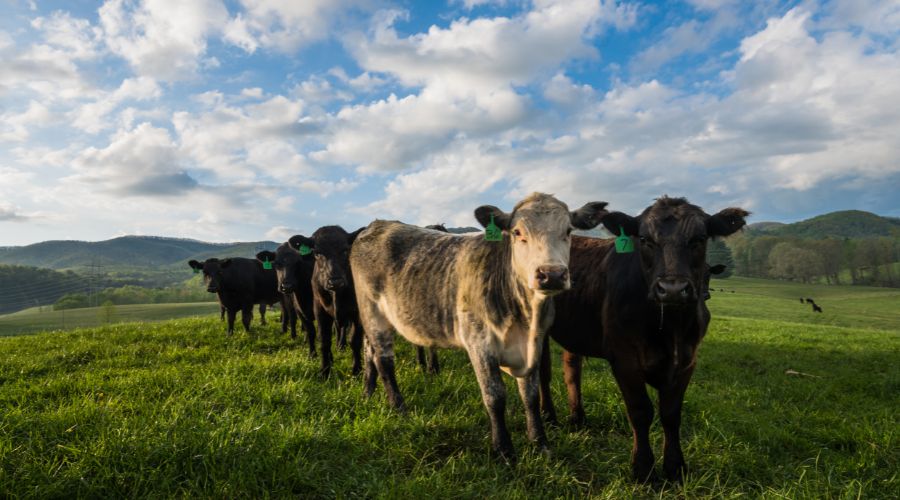Beef and Sustainability

Recognizing New York Farms for Outstanding Environmental Stewardship
The 2024 Region 1 Environmental Stewardship Award Winner: Angus Glen Farms
Angus Glen Farms is a cow-calf operation in the iconic Finger Lakes Region, an agricultural area which sees more than one million visitors each year. Cattle are used as a tool to improve the soil, forest and forage health. The farm is subdivided into 100 paddocks, with half considered silvopasture, the intentional integration of trees and livestock grazing. Cattle are moved daily to manage and reduce runoff into the nearby Seneca Lake while also promoting soil health, forage and tree growth, and improving the health of the cattle. In winter months when grass is not available, they practice bale grazing to reduce soil compaction and improve soil health in needed areas. During the summer, they keep track of temperatures and move cattle to the silvopasture for access to shade from the trees. The Chedzoy family also hosts “pasture walks” educating other producers, conservation professionals and visitors about their stewardship practices.
“Our goal, simply put, is to have a resilient and viable working farm for future generations of our family,” said Brett Chedzoy with Angus Glen Farms. “Protecting our unique landscape and watershed through sound and compatible farming practices is of the upmost importance.”
THREE PILLARS OF SUSTAINABILITY
A sustainable food system is comprised of three different, but intersecting, pillars: social responsibility, economic viability and environmental stewardship. True sustainability is a balance of these three aspects. Beef farmers and ranchers are dedicated to producing beef in a way that prioritizes the planet, people, animals, and progress.
SOCIAL
Perhaps the least explored of the three pillars is social sustainability. We define this as community and organizational resilience, based on principles such as equity, health, social capital, and well-being. For beef production, social sustainability includes worker safety, animal welfare, antibiotic and technology use, and the culture and traditions of beef producers.
ECONOMIC
The economic pillar of sustainability refers to practices that support economic success and equitability, without negatively impacting the social and environmental aspects of the community. This includes improving rural economies & livelihoods, affordability of beef to consumers, profitability of beef producers, and the value of ecosystem services. Beef farms and ranches represent over 30% of the farms in the U.S., making up the single largest segment of U.S. agriculture, and a significant component of the agricultural economy (BeefReasearch.org).
ENVIRONMENTAL
This area is concerned with protecting and enhancing natural resources, ecosystem services, and ecological health. This pillar looks at biodiversity, carbon & water footprints, wildlife habitat, soil and rangeland health, and the ability of cattle to utilize human inedible feeds, among others.
Improving Beef Sustainability In Creative Ways
Cattle have a unique four-chambered stomach, the largest chamber being the rumen, which helps them get the nutrients they need from parts of fruit and vegetable plants that humans don’t consume or can’t digest—like carrot tops, almond hulls or grasses. These leftovers are often mixed into their feed, along with other grasses or hay like alfalfa and grains like corn. Cattle are acting as “upcyclers” in our food system by upgrading human inedible material or food waste into high-quality protein and essential micronutrients.
Mike Ameele of Ameele Farms LLC. in Walworth, NY discusses how he is utilizing apple pomace on his farm. Photo Credit: Lauren Keating, Healthy-Delicious.com
For example, in New York, about 29.5 million bushels of apple are grown annually. When those apples are further processed to make new products, such as apple sauce or cider, a by-product, apple pomace, is created. Instead of the apple pomace being wasted Mike Ameele uses it on his farm to cover his feed bunk, reducing waste. Besides protecting his feed and helping it ferment the pomace also serves as a source of nutrients for his cattle.
SUSTAINABILITY ASSESSMENTS
Currently, emissions from cattle, including those that come from the feed production, fuel, and electricity only account for 3.7% of the total greenhouse gas emissions in the U.S. To better understand and optimize environmental sustainability across the entire beef lifecycle, from pasture-to-plate, cattlemen and women have recently invested in an updated environmental life cycle assessment (LCA). This in-depth assessment utilizes the most up-to-date and comprehensive methodology and includes data from seven different regions across the country. The LCA provides benchmarks on environmental contributions of the cattle industry in the U.S., and is a roadmap for the journey toward an even more environmentally sustainable approach to raising beef. An economic impact assessment for the beef industry is also being completed. This economic impact report is one way to measure economic sustainability of the beef industry and is an area that will continue to develop and progress given the significant social and economic contributions of the beef industry to the U.S. and global community.

Share This Page